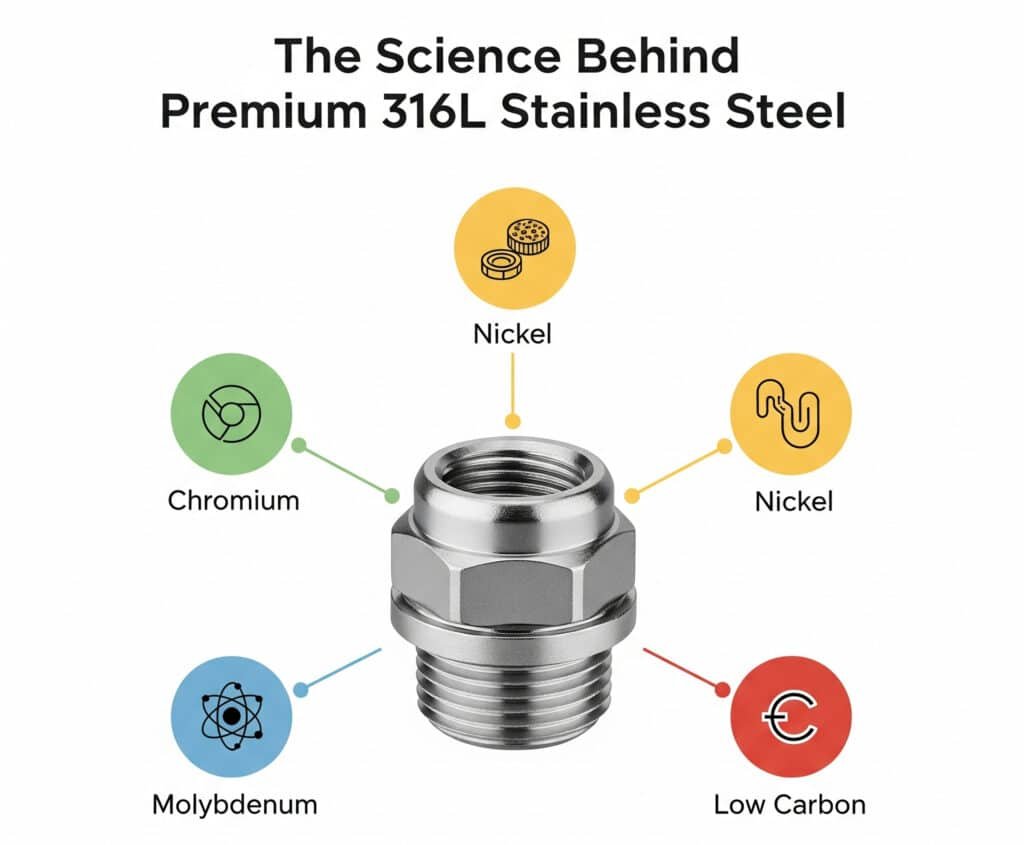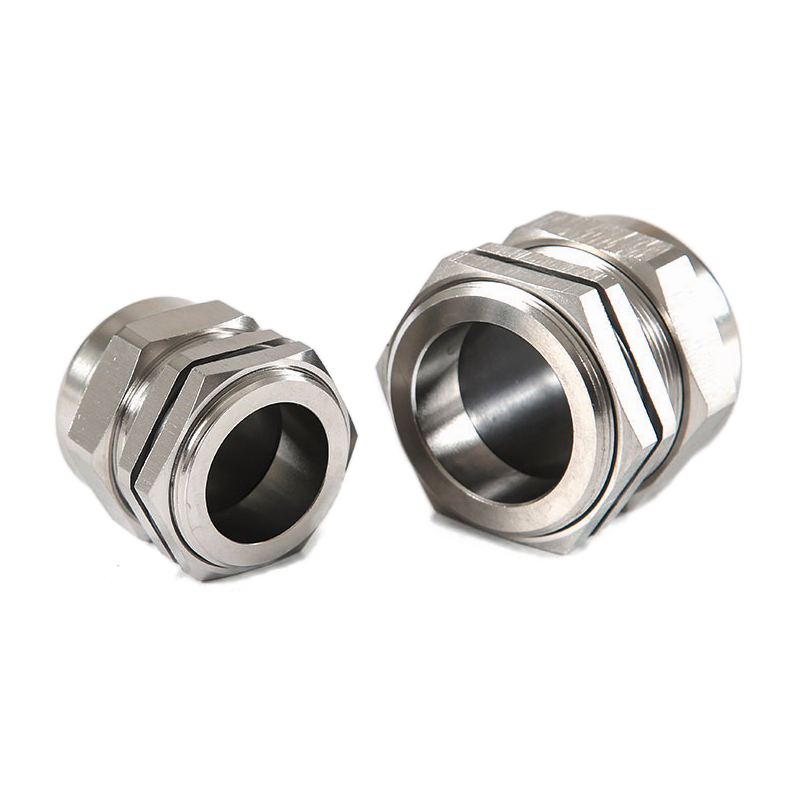You’re facing equipment failures, costly replacements, and mounting maintenance bills. Your current cable glands seem cheap upfront, but they’re bleeding your budget dry. Stainless steel cable glands offer the solution you need.
Stainless steel cable glands deliver 3-5x longer lifespan than standard alternatives, reducing total ownership costs by up to 60% through superior corrosion resistance and minimal maintenance requirements.
Last month, I met Hassan, a refinery owner from Dubai who was frustrated with replacing corroded cable glands every 18 months. After switching to our stainless steel solutions, he hasn’t had a single failure in three years.
Table of Contents
- What Exactly Is Total Cost of Ownership for Cable Glands?
- Why Do Stainless Steel Cable Glands Cost More Upfront?
- How Much Can You Actually Save Over 10 Years?
- Which Industries Benefit Most from Stainless Steel Investment?
What Exactly Is Total Cost of Ownership for Cable Glands?
Most procurement managers only see the purchase price tag. But that’s just the tip of the iceberg when it comes to real costs.
Total Cost of Ownership1 includes initial purchase price, installation costs, maintenance expenses, replacement frequency, and downtime losses – typically 4-6x the original purchase price over a product’s lifetime.

The Hidden Cost Components You’re Missing
Let me break down what TCO really includes:
| Cost Component | Standard Cable Glands | Stainless Steel Cable Glands |
|---|---|---|
| Initial Purchase | $5-15 per unit | $25-45 per unit |
| Installation Labor | $30 per unit | $30 per unit (same) |
| Maintenance/Year | $15-25 | $3-8 |
| Replacement Frequency | Every 2-3 years | Every 8-12 years |
| Downtime Cost/Failure | $500-2000 | Minimal |
Real-World Example: David’s Wake-Up Call
David, a procurement manager from a German automotive plant, called me last year in panic. His production line shut down because three brass cable glands corroded simultaneously in their wash bay area. The 6-hour downtime cost his company €15,000, not counting the replacement parts and emergency labor.
“Chuck,” he said, “I saved €200 on cheaper glands and lost €15,000 in one day. Never again.”
That’s when the TCO reality hits you hard.
Why Do Stainless Steel Cable Glands Cost More Upfront?
The price difference isn’t arbitrary – it reflects superior materials, precision manufacturing, and rigorous testing that standard glands simply don’t undergo.
Stainless steel cable glands cost 2-3x more initially due to premium 316L stainless steel material, precision CNC machining, and extensive corrosion testing that ensures 10+ year performance in harsh environments.

Material Science Behind the Premium
Here’s what you’re actually paying for:
316L Stainless Steel Composition
- Chromium (16-18%): Forms protective oxide layer
- Nickel (10-14%): Enhances corrosion resistance
- Molybdenum (2-3%): Prevents pitting in chloride environments
- Low Carbon (<0.03%): Prevents carbide precipitation2
Manufacturing Precision
At Bepto, our CNC machines maintain tolerances within ±0.05mm. This precision ensures:
- Perfect thread engagement
- Consistent sealing performance
- Uniform wall thickness for pressure resistance
Certification Costs Built Into Price
Every batch of our stainless steel glands undergoes:
- Salt spray testing3 (500+ hours)
- IP68 waterproof verification
- ATEX4 explosion-proof certification
- Material composition analysis
These aren’t cheap tests, but they guarantee performance when it matters most.
How Much Can You Actually Save Over 10 Years?
Let me show you the math that convinced Hassan to switch his entire refinery to stainless steel glands.
A typical industrial facility saves $2,500-7,500 per 100 cable glands over 10 years by choosing stainless steel, with ROI breaking even in year 2-3 depending on environmental conditions.
The 10-Year TCO Comparison
Here’s Hassan’s actual calculation for 100 cable glands in his refinery:
Standard Brass Glands Path:
- Initial cost: 100 × $12 = $1,200
- Replacements (4 cycles): 400 × $12 = $4,800
- Installation labor: 500 × $30 = $15,000
- Maintenance: 10 years × $20/unit = $20,000
- Downtime losses: 8 failures × $3,000 = $24,000
- Total 10-year cost: $65,000
Stainless Steel Glands Path:
- Initial cost: 100 × $35 = $3,500
- Replacements: 0 (still running after 3 years)
- Installation labor: 100 × $30 = $3,000
- Maintenance: 10 years × $5/unit = $5,000
- Downtime losses: $0
- Total 10-year cost: $11,500
Hassan’s savings: $53,500 over 10 years 😉
Break-Even Analysis by Environment
| Environment Type | Break-Even Point | 10-Year Savings |
|---|---|---|
| Marine/Coastal | 18 months | $4,500-8,000 |
| Chemical Processing | 24 months | $3,500-6,500 |
| Food/Pharmaceutical | 30 months | $2,500-4,500 |
| Standard Industrial | 36 months | $1,500-3,000 |
Which Industries Benefit Most from Stainless Steel Investment?
Not every application justifies the premium cost. Let me help you identify where stainless steel glands deliver maximum ROI.
Marine, chemical processing, food production, and pharmaceutical industries see 5-8x ROI from stainless steel cable glands due to extreme environmental demands and strict hygiene requirements.
High-ROI Industries and Applications
Marine & Offshore (Highest ROI)
- Salt spray exposure: Standard glands fail in 6-12 months
- Replacement difficulty: Offshore maintenance costs $500-2000 per visit
- Safety criticality: Cable failures can cause catastrophic equipment damage
Hassan’s offshore platform project used 500 of our marine-grade stainless steel glands. After 4 years, zero failures. His maintenance team tells me they’ve forgotten what cable gland replacement looks like! 😉
Chemical & Petrochemical Processing
- Corrosive environments: Acids, bases, and solvents destroy standard materials
- ATEX requirements: Explosion-proof certification mandatory
- Process continuity: Unplanned shutdowns cost $10,000-50,000 per hour
Food & Pharmaceutical Manufacturing
- Wash-down procedures: Daily high-pressure, high-temperature cleaning
- FDA compliance5: 316L stainless steel required for direct food contact
- Contamination prevention: Corrosion particles can ruin entire batches
When Standard Glands Are Sufficient
I’ll be honest – stainless steel isn’t always necessary:
- Dry, indoor environments with stable temperatures
- Low-vibration applications without chemical exposure
- Budget-constrained projects where replacement access is easy
- Temporary installations under 2 years
For these applications, our nylon or brass cable glands offer excellent value.
Conclusion
Stainless steel cable glands transform from expense to investment when you calculate true ownership costs over time.
FAQs About Stainless Steel Cable Gland TCO
Q: How long do stainless steel cable glands actually last in marine environments?
A: Our 316L stainless steel cable glands typically last 8-12 years in marine environments, compared to 6-18 months for brass or nylon alternatives. We’ve had customers report 15+ years of service in offshore applications.
Q: What’s the break-even point for switching to stainless steel cable glands?
A: Break-even typically occurs in 18-36 months depending on your environment. Marine and chemical applications break even fastest (18-24 months), while standard industrial environments take 30-36 months.
Q: Do stainless steel cable glands require special installation tools?
A: No special tools required. Our stainless steel glands use standard hex wrench installation, identical to brass or nylon glands. The threading is compatible with existing cable entry systems.
Q: Can I mix stainless steel glands with other materials in the same installation?
A: Yes, but avoid direct contact between stainless steel and carbon steel to prevent galvanic corrosion. Use appropriate washers or gaskets when necessary, especially in wet environments.
Q: What certifications do your stainless steel cable glands carry?
A: Our stainless steel cable glands carry CE, ROHS, REACH, IP68, and ATEX certifications. We also provide material certificates and salt spray test reports with every shipment for traceability.
-
Understand the TCO framework, a financial estimate that helps managers assess both the direct and indirect costs of a product over its lifecycle. ↩
-
Understand this metallurgical phenomenon and why low-carbon (“L” grade) stainless steels are crucial for preventing corrosion after welding. ↩
-
Review the ASTM standard for operating salt spray (fog) apparatus, a key method for evaluating corrosion resistance. ↩
-
Explore the European Union’s ATEX Directive, which covers equipment and protective systems intended for use in potentially explosive atmospheres. ↩
-
Learn about the U.S. FDA’s requirements for materials that come into contact with food, ensuring they are safe for their intended use. ↩



